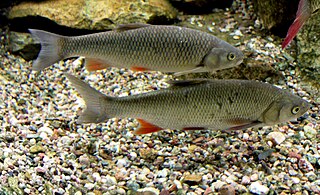
Squalius cephalus is a European species of freshwater fish in the carp family Cyprinidae. It frequents both slow and moderate rivers, as well as canals and still waters of various kinds. This species is referred to as the common chub, European chub, or simply chub.
The New Zealand urchin clingfish is a clingfish. It is found around New Zealand wherever sea urchins are present. Its length is between 2 and 3 cm.
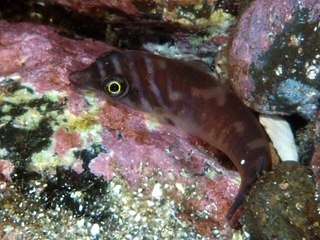
Clingfishes are fishes of the family Gobiesocidae, the only family in the order Gobiesociformes. These fairly small to very small fishes are widespread in tropical and temperate regions, mostly near the coast, but a few species in deeper seas or fresh water. Most species shelter in shallow reefs or seagrass beds, clinging to rocks, algae and seagrass leaves with their sucking disc, a structure on their chest.
Hector's clingfish, Gastroscyphus hectoris, is a clingfish of the family Gobiesocidae, the only species in the genus Gastrocyathus. It is found all down the east coast of New Zealand around the low water mark amongst seaweed, on rocky coastlines. Its length is up to 6.4 centimetres (2.5 in) SL. This species was described in 1876 by Albert Günther as Crepidogaster hectoris from a holotype collected on the south shore of the Cook Strait. Günther honoured the Scottish-born scientist James Hector (1834-1907) who was the Director of the Geological Survey of New Zealand and who presented type to the British Museum.
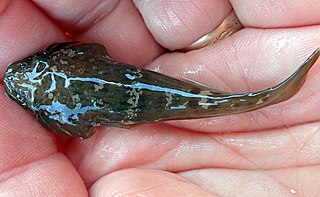
The New Zealand lumpfish is a clingfish of the family Gobiesocidae, found all around New Zealand including the Three Kings Islands, from low water to about 12 m, on rocky coastlines. Its length is up to 10 cm. This species was described as Lepadogaster pinnulatus by Johann Reinhold Forster in 1801 with a type locality of Queen Charlotte Sound, Marlborough Sounds off the South Island of New Zealand.

The northern clingfish is a species of saltwater fish. It is a member of the family Gobiesocidae of order Gobiesociformes. It is native to the Pacific coast of North America from Revillagigedo Island and Baja California north to southeastern Alaska. It is commonly found in the intertidal zone clinging to the underside of rocks by small hairs akin to those on a gecko's feet on the basal portions of the pelvic and pectoral fins. This species was described by Charles Frédéric Girard in 1858 from specimens collected at San Luis Obispo in California, Girard had originally named it as Lepadogaster reticulatus in 1854 but this name was preoccupied by Lepadogaster reticulatus Risso, 1810.

Gobiesox is a genus of clingfishes found in the Americas, including offshore islands. Most species inhabit coastal marine and brackish waters, but G. lanceolatus is a deep-water species found at a depth of around 300 m (980 ft), and seven species are from fast-flowing rivers and streams. These seven are the only known freshwater clingfish.

The blunt-snouted clingfish is a species of clingfish found along the Mediterranean Sea coasts from Syria to Spain. This species grows to a length of 5 centimetres (2.0 in) TL. The blunt-nosed clingfish is a little known species of shallow water along the littoral of the northern Mediterranean from Alicante to northern Israel. It can survive out of the water and occurs only among intertidal pebbles and sand.
Gymnoscyphus ascitus is a small species of clingfish found in the Caribbean Sea at depths of 231 to 318 m (758–1,043 ft). This species is the only known member of the genus Gymnoscyphus.
The minute clingfish is a tiny species of clingfish native to reef environments around the island of Guam, the Marshall Islands and the Northern Marianas Islands. This species is the only known member of its genus. This species was described in 1955 by John C. Briggs from a type collected off Saipan.
The streaky clingfish is a species of clingfish only known from one specimen collected off the coast of southern Mozambique. The length of the only known specimen was 2.1 centimetres (0.83 in) SL. This species is the only known member of its genus. The single known specimen was collected at Ponte Zavora in southern Mozambique by Mrs D.N. Lusher, who sent it to J.L.B. Smith. Smith described the species from this type and named it in honour of Mrs Lusher, so the spelling should be lusherae to reflect her gender.
Pherallodiscus is a genus of clingfishes native to the central eastern Pacific Ocean along the coast of Mexico. Based on genetic studies the genus should be merged into Gobiesox.

The Posidonia clingfish is a species of clingfish native to the Australia coast. This species grows to a length of 2 centimetres (0.79 in) SL. Pale green to pale blue with fine spots forming dark reticulations on back and sides, larger blue spots often on back, and a pinkish to brown line from snout to gill cover. The posidonia clingfish is endemic to southern Australia where its range extends from Corner Inlet in Victoria west as far as Rottnest Island in Western Australia. It occurs down to a depth of 10 metres (33 ft) where it is found on macroalgae and within seagrass beds, its favoured substrate to adhere to is the leaves of the sea grass Posidonia australis. This species is the only known member of its genus and was described by John C. Briggs in 1993 with a type locality of Fiddler's Bay which is 16 kilometres south of Tamby Bay in South Australia. Briggs gave the species the specific name hutchinsi in honour of the ichthyologist Barry Hutchins of the Western Australia Museum in Perth, Western Australia.
The São Tomé clingfish is a species of marine fish of the family Gobiesocidae (clingfish). It grows to 1.4 cm maximal length. It occurs in the eastern Atlantic Ocean, around the islands of São Tomé and Príncipe between 0 and 3 metres depth. The species was first described in 2007 by Ronald Fricke, its specific name honouring the collector of the type, marine biologist Peter Wirtz of Madeira.

Diplecogaster bimaculata, the two-spotted clingfish, is a species of fish in the family Gobiesocidae found in Black Sea, Mediterranean Sea and Atlantic Ocean where it is found on rocks and among seagrass or shell beds.
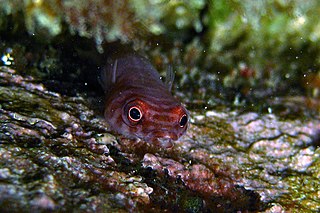
Aspasmogaster costata, the eastern clingfish or pink clingfish is a species of clingfish from the family Gobiesocidae. It is endemic to eastern Australia where it occurs from Byron Bay to the Nadgee Nature Reserve in southern New South Wales and also on Lord Howe Island in the Tasman Sea. This is a secretive species which frequently hides under rocks, shelters in crevices or behind sea urchins at depths down to 20 metres (66 ft). The species was described in 1885 by James Douglas Ogilby with a type locality of Shark Reef near Port Jackson in New South Wales.

Cochleoceps bicolor, the western cleaner clingfish, is a species of clingfish from the family Gobiesocidae which is endemic to southern Australia. This species has a ground colouration which varies from yellowish to reddish marked with regular transverse blue bands along its back and a bluish-grey caudal fin. This species occurs on rocky reefs and jetty or pier piles, where they establish cleaning stations, often over sponges and ascidians, but are known to use a wide variety of reef related sites as stations, perhaps the most important criterion being the prominent visibility of a site to passing parasite laden clients .A station may have from one to multiple Western Cleaner Clingfish, depending on the demand for services and other factors. Some divers have observed shared stations, where several other known temperate marine cleaner host species-notably juvenile moonlighter fish and rockpool shrimp - behave in cooperative fashion, possibly when client demand peaks, tide and season depending. They are thought to feed on parasites which they clean off larger fish. The distribution of this species extends from Lancelin, Western Australia to Port Phillip in Victoria. C. bicolor was described in 1991 by Barry Hutchins from a type locality of Flinders Island.

Lepadichthys sandaracatus, the Shark Bay clingfish, is a species of clingfish from the family Gobiesocidae. This species is endemic to Western Australia. This species was described in 1943 by Gilbert Percy Whitley with a type locality of Useless Inlet in Shark Bay, Western Australia.
Opeatogenys gracilis is a species of clingfish from the family Gobiesocidae which is found in the Mediterraean Sea and in the eastern Atlantic Ocean. Suggested common name for this species are the pygmy clingfish and the seagrass clingfish.
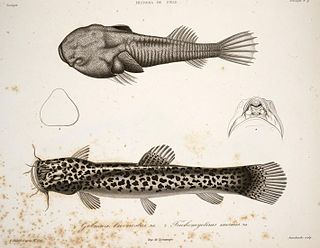
Sicyases brevirostris is a species of clingfish from the family Gobiesocidae. It is endemic to the rocky intertidal zones of the Juan Fernández Islands, Chile. It was described in 1848 as Gobiesox brevirostris by Alphone Guichenot. Fishbase treats Sicyases hildebrandi as synonymous with S. brevirostris although some authorities still treat S. hildebrandi as a valid species.












